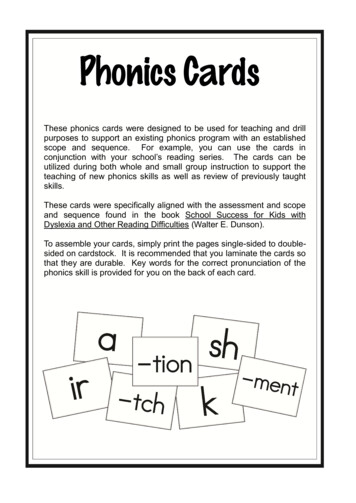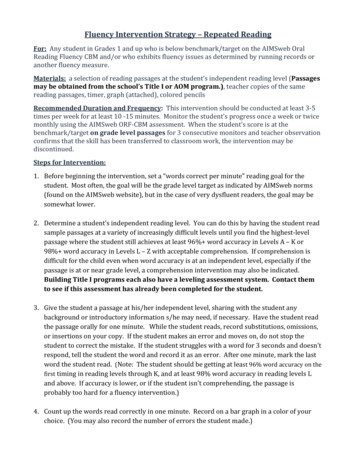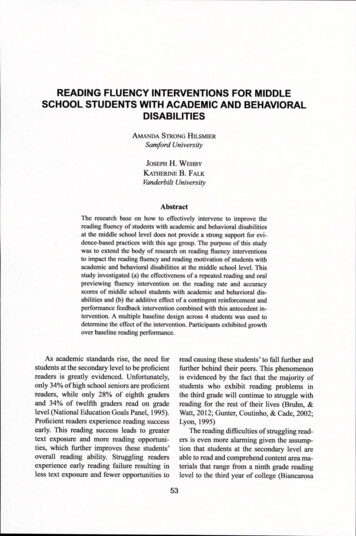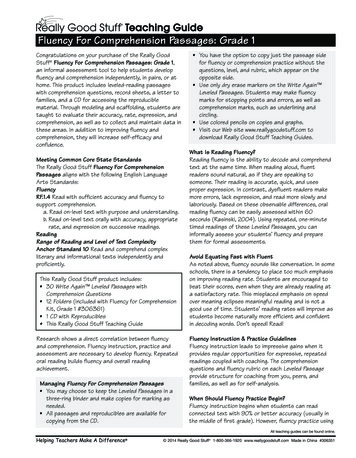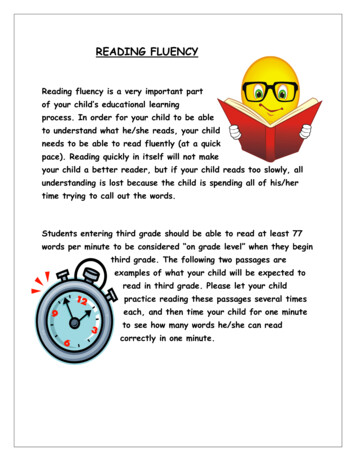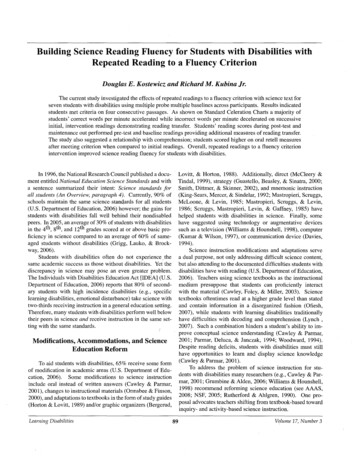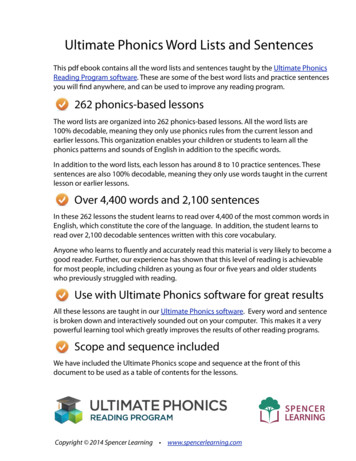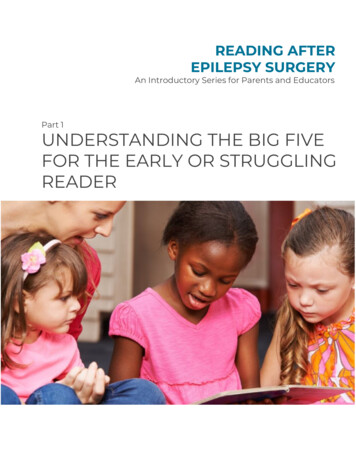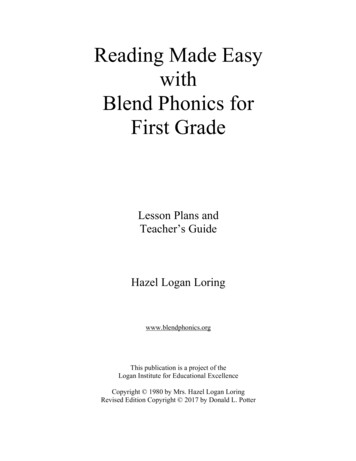
Transcription
Fluency and Phonics, Book 2CONTENTSTEACHER’S GUIDE1- 9LESSON 1 Horses(Grade 3)1LESSON 2 Paper(Grade 3)7LESSON 3 Giraffes(Grade 4)13LESSON 4 Giant Redwoods(Grade 4)19LESSON 5 The Cheetah(Grade 4)25LESSON 6 Reduce, Reuse, Recycle(Grade 4)31LESSON 7 African Elephants(Grade 5)37LESSON 8 The Painted Desert(Grade 5)43LESSON 9 The Space Shuttle(Grade 5)49LESSON 10 Trains(Grade 5)55LESSON 11 Airplanes(Grade 5)61LESSON 12 Maple Syrup(Grade 5)67Duplication of this book on a scale larger than the individual classroomis permitted only with the publisher’s written approval.www.StrugglingReaders.com1
TEACHER’S GUIDEINTRODUCING THE PROGRAMFluency and Phonics, Book 2, is a reading program that builds onstudents’ natural language abilities to develop word recognition and readingfluency in an interesting reading passage context. The program alsoincludes phonics in a rhyming word context from the reading passages.Fluency and Phonics, Book 2, has 12 lessons with gradedreading passages from high grade 3 through high grade 5 reading levels.Each of the 12 lessons includes phrase-cued reading, repeated reading,timed reading, and reading with expression all of which develop readingfluency.Phrase-Cued Reading is breaking the text into meaningful phrases tohelp with reading expression and comprehension.Repeated Reading is reading the same passage until students read thepassage at a mastery level.Timed Reading is reading a passage for one or two minutes andrecording the number of words read per minute.Reading with Expression is important for developing comprehension ofa passage.The program method produces exceptional reading success for at-riskreaders having one or more of the following reading characteristics:need a sense of the whole story before reading;experience difficulty blending sounds;read letter by letter, word by word;have strong verbal skills and weak written language skills; andexhibit delays in cadence and rhythm.Fluency and Phonics, Book 2, also is used with young readers toimprove reading speed and fluency.2
Starting the ProgramStudents’ Starting LevelTo start the program, students should read at grade 3 or higher readinglevel. Passage reading levels are listed in the program contents onpage 1. If teachers know students’ reading levels, they start them with thefirst lesson at those levels. Students may read at higher reading levels butexhibit problem reading characteristics such as:- read letter by letter, word by word and- exhibit delays in cadence and rhythm.For any of the twelve lessons, if students read words correctly but readword by word and lack expression, have them start with that lesson. It isbetter to start with an easier lesson. For groups, choose students withsimilar reading levels and abilities.Students’ Reading Mastery LevelTeachers determine reading level required for mastery. A 70 percentreading mastery level works well because students will see many of thesame words again in further lessons.Students’ Extended ReadingStudents participate in extended reading with books of their interests whileusing the program to reinforce reading skills.Using the ProgramTeacher Instructions, Lessons 1 Through 12The program is easy to use because all twelve lessons have the samestructure. Becoming familiar with lesson 1 structure is all that is necessaryto teach all twelve lessons.3
Lesson 1For the Teacher:For each student, duplicate and staple lesson pages 1, 2, 3, 4, 5, and 6 tomake the lesson 1 packet. (When you are ready to start lesson 1, give alesson packet to each student.)Pages 1 and 2 (Word Recognition, Phrasing, andExpression)Pages 1 and 2 develop word recognition, phrasing, and expression, allimportant to reading comprehension. They provide students with a readingmodel that moves them away from word-by-word reading to reading inmeaningful phrases.The pages have phrase-cued text. Phrase-cued text divides text accordingto natural pauses that occur in and between sentences. Phrase breakshelp students who have difficulty grouping words that go together andtherefore lack rhythm and expression. One slash (/) are in-sentencephrase markers. Make a slight pause at each phrase marker. Two slashes(//) are end-of-sentence markers. Pause slightly longer at two slashes.Instruction 1. Discuss Title of the Passage, Horses. (Page 1)Ask students what they think the passage will be about. For example, thefirst passage is about horses. Ask, “Can you tell me some things abouthorses?” (Discussing the passage title is important because it builds anetwork of information that helps with comprehension and wordidentification.) Have students draw a picture of a horse in the box at thetop of the page or paste a picture of a horse there.Instruction 2. Read Entire Passage, Horses. (Pages 1 and 2)While you are reading the passage, students follow along, moving theirwriting hands under each word and touching the page. This is tracking.4
Tracking trains students’ eyes and hands to coordinate. It also insures thatstudents are looking at each word as it is read.-For the first practice, read at a slow pace but not so slow as to lackexpression. Reading with expression is important. Make a slight pause ateach phrase marker.-Do a second practice reading while reading at a normal pace and havingstudents track under the words.(NOTE: If phrase markers cause student visual difficulty, have students use page 6rather than pages 1 and 2. Page 6 is the passage without phrase markers.)Instruction 3. Students Read Passage Parts and Passage. (Pages 1and 2)Have students read the passage or passage part with you. When studentshave difficulty with words, you say the words and continue reading.As you read together, students move their hands under the words.(Students do not need to master the passage now because they will bedoing added activities to help them read the passages.)PAGE 3, PART 1Instruction 1. Read passage part in the box with students.Instruction 2. Multisyllable Words. Students write multisyllable wordson the lines.Instruction 3. Rhyming Words. Students write rhyming word pairs.(Rhyming words are words that have the same ending sounds.) Whencompleted, read multisyllable words and rhyming word pairs with students.Continue with the rest of the passage part activities for pages 3 and 4in same way as part 1.5
PAGE 5 (TIMED READING)Timed reading improves reading speed. If decoding is slow, not automatic,students have difficulties comprehending what they read.Instruction 1. Passage Reading PracticeBefore timing, you and all students read the passage together. Studentstrack under words and read along with you as you read with expression ata normal reading pace. If students need additional practice, they read tothemselves or to partners.Instruction 2. Timed ReadingIndividually, students read as many words in the passage as they can intwo minutes, to you, aloud softly to themselves, or to student partners. Ifstudents finish reading, they start again at beginning and add to the totalnumber of words they have already read. (For some students, timing forone minute works better.) Subtract one point for each missed word. Ifstudents make mistakes, do not have them try to sound out thewords. Tell them the word and they continue reading.After students complete timed reading, they write their scores on the linesunder Timed Reading. Their scores are made from number of words readminus 1 point for each missed word. Have students do 3 one-minutetimed readings or 3 two- minute timed readings. Between timings, askstudents to look over the selection, reread it, and practice words thatcaused difficulty. Students circle their best scores. Students gain readingskills, and also enjoy timed readings. Repeat previous timed readings forstudents to improve their scores. Making graphs of their timed readingscores motivates students. Graph masters are on pages 8 and 9.6
PAGE 6 (READING WITH EXPRESSION)Reading with expression is important for developing comprehension of apassage.Use pages 1 and 2, Phrase-Cued Text, for the first passage practice.Students track under the words and read along with you as you read withexpression at a normal reading pace.Use page 6, Regular Text. Students track under words and read alongwith you as you read with expression at a normal reading pace. If studentsneed additional practice, they read to themselves or to student partners.Listen to as many students’ expressive readings as possible. Do notrequire students to read to the class unless they volunteer. Forcomprehension development, ask students questions about the passagesand discuss the passages.7
REPEATED READING GRAPH(Graph 1)Student:Book:Check One[ 50 Word Passage[T 100 Word Passage10000yTyppeMasteryeRangeaWords ReadaqErrorsquScoreouotteeffrroWords ReadommErrorst ScorethheeddooccuWords ReadumeErrorsmneScorenttoorrtthheesWords Per MinutesuummmamarryyooffTrial # 1900008000Trial # 2Trial # 3700060005000400030001823
REPEATED READING GRAPH(Graph 2)Student:Book:Check One[ 50 Word Passage[T 100 Word Passage14000yTyppe130eaWords ords ReadommErrorst Scorethhe100eddooccuWords Readum90eErrorsm00neScoretntoor80rt00thheesWords Per Minute70su00ummmamarryyooffTrial # 1Trial # 2Trial # 31923
LESSON 1HorsesPeople love horses.// Thereare different / kinds of horses.//There are / huge draft horses.//They are over / 7 feet tall.//There are / small horses.//Some / are called ponies.//One kind / is smaller than /most dogs.//Once,/ horses were used / forwork on farms.// They pulledplows / and farm carts.// Now,/tractors are used / for mostfarm work.// In some places /horses still / are used forwork.// But today,/ horses areused / mostly for / trail-riding,/showing,/ and more.//Phrase-Cued TextCOPYRIGHT 2012, GLAVACH & ASSOCIATES1
LESSON 1Horses(continued)Here are / some interesting facts /about horses.// They can sleep /lying down.// They can sleep /standing up.// Horses gallop / atabout / 27 miles per hour.// Thefastest speed / of a horse / is 55 /miles per hour.// Horses eat /grass,/ oats, / hay,/ and otherplants.//Once,/ most horses / were wild.//Wild horses / are calledmustangs.// The horse was / oneof the first / wild animals / to betamed.// Today,/ there are few /wild horses.// Would you like / toride / a wild horse? // Or,/ wouldyou like / to ride / a tame horse? //Phrase-Cued TextCOPYRIGHT 2012, GLAVACH & ASSOCIATES2
PART 1People love horses. There are different kinds ofhorses. There are huge draft horses. They areover 7 feet tall. There are small horses. Someare called ponies. One kind is smaller than mostdogs.Write the words as one word.dol lardif fer entsmall erWrite the rhyming word.1. love – gl2. there – wh3. kind – f4. raft – dr5. feet – m6. tall – sm7. tall – c8. one – d9. most – pPART 2Once, horses were used for work on farms. Theypulled plows and farm carts. Now, tractors areused for most farm work. In some places horsesstill are used for work. But today, horses areused mostly for trail-riding, showing, and more.Write the words as one word.trac torsto dayshow ingWrite the rhyming word.1. use – f2. farm– h3. pull – f4. cow – pl5. carts – p6. race– pl7. tail – tr8. show – gr9. more – stCOPYRIGHT 2012, GLAVACH & ASSOCIATES3
PART 3Here are some interesting facts about horses.They can sleep lying down. They can sleepstanding up. Horses gallop at about 27 milesper hour. The fastest speed of a horse is 55miles per hour. Horses eat grass, oats, hay, andother plants.Write the words as one word.in ter es tingly ingstand inggal lopa boutfast estWrite the rhyming word.1. act – f2. ant - pl3. pass – gr4. land – st5. fast – p6. mile – f7. need – sp8. deep – sl9. out – aPART 4Once, most horses were wild. Wild horses arecalled mustangs. The horse was one of the firstwild animals to be tamed. Today, there are fewwild horses. Would you like to ride a wild horse?Or, would you like to ride a tame horse?Write the words as one word.mus tangsan i malsWrite the rhyming word.1. wild – m2. tame – c3. one – d4. call – t5. few – n6. there – wh7. first – th 8. would – c 9. could – shCOPYRIGHT 2012, GLAVACH & ASSOCIATES4
TIMEDREADINGCOPYRIGHT 2012, GLAVACH & ASSOCIATESHorses (1)People love horses. There aredifferent kinds of horses. There arehuge draft horses. They are over7 feet tall. There are small horses.Some are called ponies. One kindis smaller than most dogs.5Once, horses were used for workon farms. They pulled plows andfarm carts. Now, tractors are usedfor most farm work. In someplaces horses still are used forwork. But today, horses are usedmostly for trail-riding, showing, andmore.41Here are some interesting factsabout horses. They can sleeplying down. They can sleepstanding up. Horses gallop atabout 27 miles per hour. Thefastest speed of a horse is 55miles per hour. Horses eat grass,oats, hay, and other plants.83Once, most horses were wild.Wild horses are called mustangs.The horse was one of the first wildanimals to be tamed. Today, thereare few wild horses. Would youlike to ride a wild horse? Or, wouldyou like to ride a tame 22132140146152160167
reading passages from high grade 3 through high grade 5 reading levels. Each of the 12 lessons includes phrase-cued reading, repeated reading, timed reading, and reading with expression all of which develop reading fluency. Phrase-Cued Reading is breaking the text into meaningful phrases to help wi

